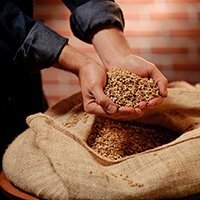Nearly extinct in its native England, porter beer’s revitalization began in the 1970s as a result of efforts from the Campaign for Real Ale, a volunteer organization in England that promotes “real ale, community pubs and consumer rights,” and American craft brewers.
Historical accounts generally agree that prior to the 1700s, brewers always released their beer, called “mild,” to pubs when freshly brewed. This mild beer might actually be terribly harsh, so it was up to publicans to age and mellow the beer before serving. But aging could also result in sourness and other undesirable flavors.
An often-cited account of porter’s origin says that in order to get the most desirable and palatable beer, pubs would “thread” or blend a portion of three different beer casks into each patron’s mug. They used a freshly brewed “mild” beer, aged sour beer and ale that was less-hopped. Some called the mix “three threads,” and it came to be a favorite of the working-class river and street laborers – the porters – of the period. Other historical references to porter indicate it evolved from London brown beer with more hops and longer storage and aging.
Today, the two versions of English Porter include Robust Porter and Brown Porter. Robust Porter is probably most like the original porter of early 1700s England. It lives up to its name by showing marked boldness of roasty, burnt malt character and bitterness and moderate-to-high levels of hop bitterness, with ABV reaching greater strength than Brown Porter in some examples. Color ranges from medium-dark brown to black. American craft brewers produce inspired versions of this brew, classified in the American Porter category.
Brown Porter is generally the most easygoing version in terms of flavor and strength. Similar to English Dark Mild Ale, it came about as a result of the use of pale malts, which reduced the brown-malt astringency long associated with the original porters. Nonetheless malty by nature, Brown Porter ranges from light to dark brown and typically exhibits a chocolaty character with associated toffee and caramel notes. Some examples may show toasty or coffee notes. Roast (not burnt) flavors may be present, but subdued. Generally mild bitterness from English hop varietals fluctuates across examples.
Characteristics: Malty, toffee, chocolaty, toasty, medium-bodied
ABV range: 3.5-6.5% IBU: 20-50
Popular English Porter-style beers: Samuel Smith’s Taddy Porter, Fuller’s London Porter, St. Peter’s Old Style Porter, Meantime London Porter, Salopian Entire Butt English Porter, Ridgeway Santa’s Butt, Left Hand Black Jack Porter, St. George Porter
Serving Temperature: Cool, 46-54°, to cellar, 55-57°
Cheese Pairing Ideas: Asiago, Brie, Colby, Emmental, Gloucester, aged Gouda, Gruyère
Food Pairing Ideas: Roasted, smoked and barbecued meats; chili and hearty stews; cheesecake



